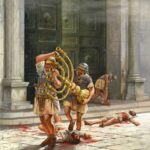Triumphal arches are the most characteristic buildings of Roman architecture. Constructed in recognition of merits for victorious leaders. Closely related to the triumphal ritual. The commander-in-chief, consul, dictator or praetor who led the campaign alone had the right to triumph in wars in which at least 5,000 enemy soldiers were killed.
The triumphal arch was a gate with a façade decorated with carvings and columns, with an attic with inscriptions in honour of the hero. The arch was crowned with a statue of the winner at the top.
The oldest triumphal arches were created in the 2nd century BCE but they have not survived. A lot of these buildings have survived to our times, in Rome alone we can admire the arches of Octavian Augustus, Titus, Septimius Severus, Galien, Constantine the Great.
An arch, or bow, is a structural or decorative element, curved and supported at both ends. Decorative arches occur mainly against the background of walls and are made in stucco or plaster. Structural arches are used in vaults to cover all types of openings, as spans of bridges, viaducts, etc. Their task is to transfer the self-weight and the lifted weight to the side supports.
In contrast to the beam, in addition to vertical reactions, the arc also experiences horizontal support, called the arch’s spread. With vertical loading and with properly selected dimensions, only compressive stresses can occur in arches, thanks to which it is possible to construct non-welded arches in places of contact with elements.







